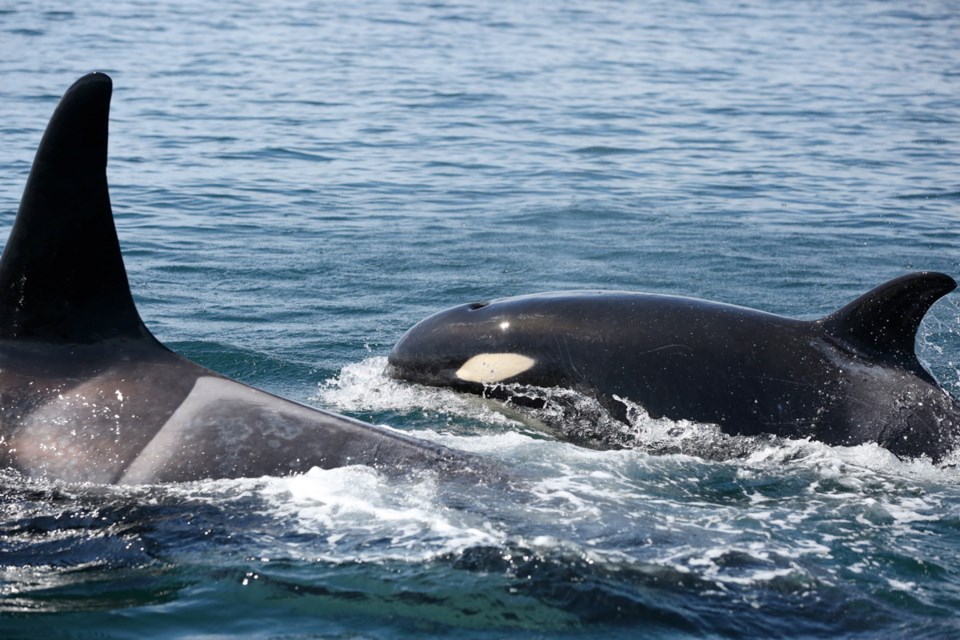A federal action plan to save endangered orcas that includes fishery closures and marine habitat protection won’t be enough, critics say.
Christianne Wilhelmson, executive director of environmental group the Georgia Strait Alliance, said the plan includes too much research and monitoring and not enough “sharp tools” for protecting northern and southern killer whales.
“The action plan lacks immediate action,” Wilhelmson said.
Fisheries and Oceans Canada has posted the proposed plan and is accepting public comment until Aug. 14.
As the first federal action plan protecting an endangered marine species, it’s expected to set a precedent for the way endangered species are treated.
In 2001, southern resident killer whales were designated as endangered, and northern resident killer whales as threatened.
The southern population declined about three per cent per year between 1995 and 2001, the plan says.
Today, there are an estimated 80 to 85 remaining. The northern population dropped by about seven per cent per year between 1997 and 2001. It grew to 280 whales in 2014 from 219 in 2004.
The biggest human-caused threats to the orcas’ recovery are availability and quality of prey, environmental contamination and physical and acoustic disturbances, the plan says.
Its recommendations fall under broad areas including: monitoring the population, ensuring adequate food supplies, ensuring human disturbances don’t prevent recovery, ensuring pollutants don’t prevent recovery and protecting critical habitat.
Wilhelmson commended the plan’s consideration of habitat protection, but said a lack of explicit authority for preventing contamination means no accountability.
And while she hailed possible fisheries closures as a positive step, anglers disagreed.
Christopher Bos, president of the South Vancouver Island Anglers Coalition, said closing fisheries is more about optics than action.
“This is the government appearing to try to do something that has no cost to the government [itself], but it has huge socio-economic and cultural implications for all harvesters,” he said.
“Historically, closing fisheries does not lead to a recovery of low abundance stocks or stocks of concern.”
Bos pointed to a 2013 briefing presented to the National Oceanic and Atmospheric Administration in the U.S. It was prepared by U.S. federal commissioner to the Pacific Salmon Commission Larry Rutter.
The briefing called it a “gross extrapolation,” to assume any particular fishery would affect the southern resident killer whale population growth rate.
Instead, the best potential for increasing chinook numbers is freshwater habitat restoration, reducing downstream migration mortality and improving ocean conditions, it said.
Closing recreational fisheries would be like denying the whales a snack, Bos said, when the real change has to be on a bigger scale through salmon enhancement projects.
The South Vancouver Island Anglers Coalition has initiated a salmon enhancement project to feed the orcas, stocking 200,000 chinook smolts in the Sooke Basin.
Henry Clifton, director of the Native Brotherhood of B.C., also took issue with a fisheries closure. He said restrictions are already far too heavy on Fraser River First Nations, who have a legal right to fish over commercial and recreational fishermen, but are subject to conservation restraints.
“It would put another noose around the fisherman’s neck,” Clifton said.
But Aaron Hill, executive director for the Watershed Watch Salmon Society, said chinook populations are too low to avoid a closure.
“Fisheries closures are always heartbreaking. I’m a recreational salmon fisherman and I would prefer not to have to stop fishing. But unfortunately, when we’re in dire situations, like the one with chinook salmon, it’s called for,” he said.
He cited a DFO-commissioned study that found a decreasing abundance in south coast chinook population.
“They’re in horrible shape and we need to take strong action to rebuild them,” Hill said.
Chinook, which make up the bulk of southern resident killer whale diets, have been threatened by changing ocean conditions, as well as degraded habitats and overfishing.
Enhancement is important, but restoring and protecting habitat should take priority over hatcheries, he said.
“Pumping out more chinook salmon from hatcheries is a very risky thing for wild populations. When we artificially propagate salmon, we interfere with the natural selection process and that degrades the genetic integrity of the stock,” he said.



